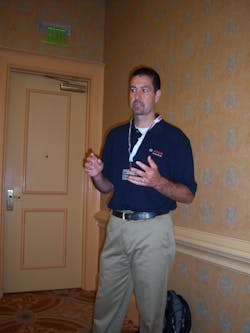Bosch Automotive updates distributors on HFO-1234yf refrigerant equipment at ISN show
As auto manufacturers begin using the new HFO-1234yf refrigerant, more and more repair shops will be investing in air conditioning (AC) equipment that recovers, recharges and recycles the new refrigerant. In the interest of educating tool distributors about new refrigerant equipment, Tim Wagaman, senior product manager for AC tools and equipment at Robinair, a brand in the Bosch Automotive Service Solutions portfolio, gave an overview of evolving refrigerant equipment during the recent ISN Tool Dealer Expo in Orlando, Fla.
Wagaman gave a historical overview of HFO-1234 and noted that in 2006, the European Union issued its mobile air conditioning (MAC) directive calling for refrigerants with a global warming potential (GWP) of less than 150. In response, manufacturers came up with solutions that were designed around HFO-1234yf, which has a GWP of 4.
“It isn’t until 2017 that this new refrigerant will have to be used on all vehicles in Europe,” Wagaman noted.
Since the directive is mandated for European vehicles, why do U.S. manufacturers care? One probable reason is that by using this refrigerants, carmakers can earn Corporate Average Fuel Economy (CAFÉ) credits to meet U.S. Environmental Protection Agency (EPA) rules. The U.S. EPA has determined that A/C systems using the new HFO-1234yf refrigerant uses less energy than the traditional A/C systems that used 134a refrigerant, meaning carmakers are eligible to receive CAFÉ credits by using the new refrigerant due to the reduced energy consumption and emission levels.
The question that most aftermarket shops ask about the new refrigerant is whether or not new tools will be needed to handle it, and the answer to this is “yes,” according to Wagaman. “Yes, and it all has to do with the mild flammability classification that has been given to this new refrigerant,” he said. This led to new SAE requirements for equipment and tools manufacturers must meet for products designed t service HFO-1234yf A/C systems.
Some of the changes noted are recover, recharge and recycle (RRR) machines have different hoses and couplers for the new refrigerant, Wagaman said. The RRR machines have to be able to identify the refrigerant in the vehicle's A/C system prior to recovery. There are two types of HFO-1234yf refrigerant identifiers -- an internal identifier in the machine and an external, handheld unit that can be used by itself or in conjunction with an RRR machine.
In addition, there will be no onboard fluid injections of any type on HFO-1234yf RRR equipment, so features like oil and dye injection using the RRR machine to perform the task will no longer be an option.
Servicing procedures will also be slightly different. The machine has to charge a portion of the refrigerant, then instruct the user to take an electronic leak detector and check compartment areas. If a leak is detected, it has to be fixed before the charge can be completed.
If no leak is detected, the machine will continue and complete the charge.
SAE International has a website that lists equipment that meets its HFO-1234yf standard: http://macdb.sae.org/. “The number of products and the number of manufacturers are growing,” Wagaman said.
Organizations like MACS and the industry in general are trying to place a bigger emphasis on technician training for the new refrigerant by creating new courses and certification testing which now includes HFO-1234yf, he noted.
Wagaman said the automotive industry has been slow to use the new refrigerant because of some setbacks that occurred after the European governments announced the directive. One setback was the 2010 Asian tsunami, which set back production timelines.
Then in 2012, the German carmaker Daimler announced that its own tests showed the new refrigerant was unsafe due to its flammability. A panel of engineeers from 11 automotive manufacturers convened by SAE International reviewed the testing and determined that the refrigerant is safe. No OEM involved in the review had provided information that would suggest a concern for the safe use of R-1234yf in their vehicles, he siad.
To date, the only U.S. made vehicle that uses the new refrigerant is the 2012 Cadillac XTS, Wagaman said. He noted that in 2013, the Chevy Spark and the Chrysler Jeep Cherokee will use it as well.
The new refrigerant is more expensive than the traditional 134a refrigerant, he noted. “The biggest challenges with the refrigerant for the aftermarket will be the cost if it stays at or close to current levels,” he said. He noted the new refrigerant was in the neighborhood of $900 per cylinder based on pricing he has seen, which is about $82 per pound for an 11-lb cylinder, compared to $140 to $160 per cylinder and $5 per pound for R134a.
In the near term, the aftermarket will need to work with both refrigerants as the new one phases in and the old one phases out. “That (new) population is going to start growing but will be slow,” Wagaman said. “It’s a gradual phase in for this refrigerant.”
He noted that Bosch has the Robinair AC1234-6, which includes an internal refrigerant identifier, and a fully automatic leak detector, the Robinaire 22791. The leak detector can be used with both types of refrigerants.
Asked if he considers the new refrigerant to be significantly flammable, Wagaman said he does not. He said it is less flammable than other chemicals used in vehicles today.
